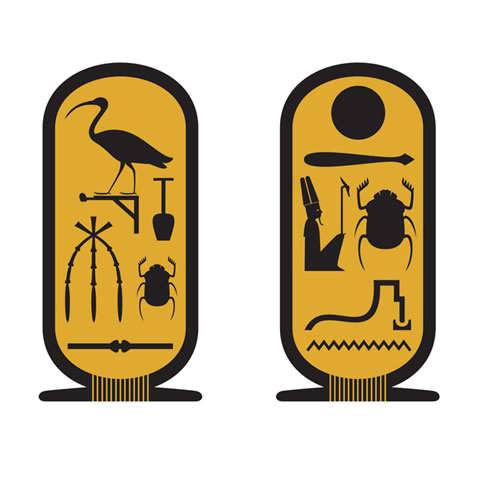Symbol of power and authority.
The cartouche symbol is shaped like an oval with hieroglyphs in the middle and a bar underneath. The circle surrounding the hieroglyph is believed to represent a magical rope, while the line underneath represents the place the rope is tied together. The rope circle represents everything being enclosed by the sun which symbolized the king’s power over the universe.
Cartouches were displayed on pharaohs’ tombs in ancient Egypt. Egyptians believed if a person’s name was recorded, they would not disappear after death. The cartouche acted as an identifier. Some pharaohs wore them to dissuade bad luck and attract good spirits. The oval around their name protected them from evil spirits after death. At certain times in Egyptian history, the names were left off of the cartouche because the people believed if someone obtained a cartouche with their name, that person would be able to control the person who was named on the cartouche. They were first used in Ancient Egypt in 2800-2700 BC. They became prevalent in 2600-2500 BC.
The cartouche was originally called a shenu. French soldiers originally used the term cartouche because the symbol reminded them of a muzzle-loading firearm’s paper powder cartridge, a cartouche.
Today, cartouches are found as pendants on necklaces and other jewelry.
Symbols Menu:» Amulet
» Ajna
» Arsenic
» Merkaba
» Hung
» Yin Yang
» bindi
» IK Onkar
» Khanda
» Halo
» jiahu
» Tau
» Uraeus
» Menorah
» Quincunx
» Tilaka
» Taijitu
» Vajra
» Chai
» Chi Rho
» Bagua
» Dragon
» Hunab Ku
» Caduceus
» Infinity
» Ichthus
» Hedjet
» Lauburu
» Om
» Ankh
» Chalice
» Pentacle
» Maat
» Ogham
» Mandala
» Kartika
» Khamsa
» Heart
» Labrys
» Sun Face
» Raven
» Triskele
» Scarab
» Dove
» Hanukia
» Anubis
» Trishula
» Durga
» Mezuzah
» Bay Tree
» Geruda
» Kinnara
» Quito
» Condor
» Blue Jay
» Falcon
» Makara
» Rosary
» Uluru
» Apsaras
» Hanuman
» Serpent
» Minotaur
» Mercury
» Apex
» Vestra
» Yoni
» Astarte
» dakini
» Calabash
» Mandrake
» Rebis
» Typhon
» Vegvísir

